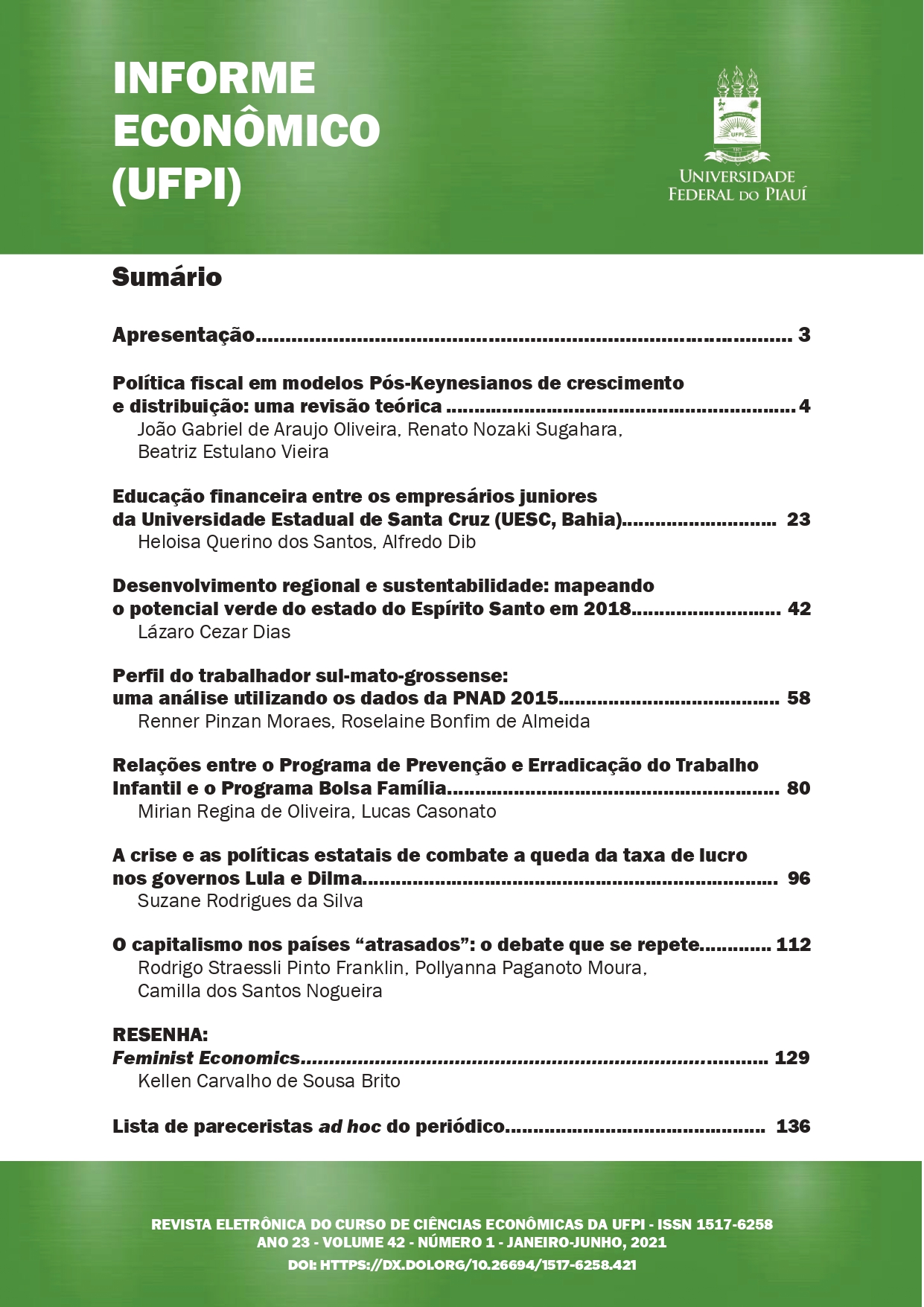Política fiscal em modelos Pós-Keynesianos de crescimento e distribuição: uma revisão teórica
DOI:
https://doi.org/10.26694/1517-6258.873Keywords:
Distribuição de renda, Políticas governamentais, Política fiscal, Política macroeconômicaAbstract
In this paper, the review method was utilised to expose a synthesis of the controversy of capital through the impact of government activities on the theory of economic growth and long-term income distribution from Kaldor-Pasinetti and its extensions. Emphasis is placed on government activities, which are exogenously presented, and the implications of introducing this sector to the model through fiscal policies and considering specific incentives for other classes are shown. In conclusion, most of the models presented by the government confirm Pasinetti's result and indicate that the regulation of the economy occurs through fiscal policies that are controlled by the public sector.
References
ARAUJO, J. T. Modelos Macroeconômicos de Simulação: Extensões dos Modelos Básicos de Kaldor e Pasinetti e Aplicações à Política Econômica Brasileira. 162f. Dissertação (Mestrado em Economia) – Departamento de Economia, Universidade de Brasília. Brasília, 1990.
______. Kaldor’s Neo-Pasinetti Model and Cambridge Theory of Distribution. The Manchester School, Manchester, v. 63, n. 3, p. 311-317, set. 1995.
CHARLES, S. The political role of the State in Cambridge theories of growth and distribution. Revista de Economia Política, São Paulo, v. 27, n. 4, p. 567-574, out. 2007.
DALZIEL, P. Cambridge (U.K.) versus Cambridge (Mass.): a Keynesian solution of “Pasinetti’s Paradox”. Journal of Post Keynesian Economics, Armonk, v. 11, n. 4, p. 648-653, 1989.
______. A Generalisation and Simplification of the Cambridge Theorem with Budget Deficits. Cambridge Journal of Economics, Cambridge, v. 15, n. 3, p. 287-300, set. 1991.
DE ARAUJO OLIVEIRA, J. G.; SUGAHARA, R. N.; TEIXEIRA, J. R. A Generalize Kaldor neo-Pasinetti Model with Political Orientation and Considering an Open Economy. In: National Meeting of ANPEC, 47, 2019, São Paulo. Anais eletrônicos… São Paulo: 2019, p. 1-20. Disponível em: <https://www.anpec.org.br/encontro/2019/submissao/files_I/i6-2f78c2705c5a85b80d3c7ca5702b319e.pdf>. Acesso: 10 jun. 2020.
DE ARAUJO OLIVEIRA, J. G.; TEIXEIRA, J. R. 2020. A Note Reconsidering a Post-Keynesian Model of Growth and Distribution the Globalization Context. Metroeconomica, Hoboken, v. 71, n. 3, 2020.
DENICOLÓ, V.; MANTTEUZZI, M. Public Debt and the Pasinetti Paradox. Cambridge Journal of Economic, Cambridge, v. 14, n. 3, p. 339-344, set. 1990.
DOMAR, E. O. Capital Expansion, Rate Growth, and Employment. Econometrica, New Haven, v. 14, n. 2, p. 137-147, abr. 1947.
FLECK, F. H.; DOMENGHINO, C. M. Cambridge (U.K.) versus Cambridge (Mass.): A Keynesian solution of “Pasinetti’s Paradox”. Journal of Post Keynesian Economics, Armonk, v. 10, n. 1, p. 22-36, 1987.
HARROD, R. F. An Essay in Dynamic Theory. The Economic Journal, Oxford, v. 49, n. 193, p. 14-33, mar. 1939.
MEADE, J. E. The Rate of Profit in a Growing Economy. The Economic Journal, Oxford, v. 73, n. 292, p. 665-674, dez. 1963.
OREIRO, J. L., MAGALHÃES, L. C. G. Cambridge Equation and the neo-Pasinetti Theorem in post-Keynesian Models of Growth and Distribution. Revista de Economia Política, São Paulo, v. 39, n.3, p. 485-508, 2019.
JONES, H. G. An Introduction to Modern Theories of Economic Growth. 1 ed. McGraw- Hill, 1976.
KALDOR, N. Alternative Theories of Distribution. The Review of Economic Studies, Cambridge, v. 23, n. 2, p. 83-100, 1956.
______. Marginal Productivity and Macro-Economic Theories of Distribution: Comment on Samuelson and Modigliani. The Review of Economic Studies, Cambridge, v. 33, n. 4, p. 309-319, out. 1966.
PASINETTI, L. Rate of Profit and Income Distribution in Relation to the Rate of Economic Growth. The Review of Economic Studies, Cambridge, v. 29, n. 4, p. 267-279, Oct. 1962.
______. Ricardian debt/taxation Equivalence in the Kaldor Theory of Profits and Income Distribution. Cambridge Journal of Economics, Cambridge, v. 13, n. 1, p. 25-36, Mar. 1989a.
______. Government Defict Spending is Not Imcompatible with the Cambridge Theorem of the Rate of Profit: A Reply to Fleck and Domenghino. Journal of Post Keynesian Economics, Armonk, v. 11, n. 4, p. 641-647, 1989b.
KING, J. E. Nicholas Kaldor after Thirty Years. PSL Quarterly Review, Roma, v. 69, n. 277, p. 107-133, 2016.
RYOO, S.; SKOTT, P. Fiscal and Monetary Policy Rules in an Unstable Economy. Metroeconomica, Hoboken, v. 68, n. 3, p. 500-548, 2017.
SAMUELSON, P. A.; MODIGLIANI, F. The Pasinetti Paradox in Neoclassical and More General Models. The Review of Economic Studies, Cambridge, v. 33, n. 4, p. 269-301, 1966.
STEEDMAN, Ian. The State and the Outcome of the Pasinetti Process. The Economic Journal, Oxford, v. 82, n. 328, p. 1387-1395, Dec. 1972.
TAYLOR, J. B. Discretion versus Policy Rules in Practice. Carnegie-Rochester Conference Series on Public Policy. v. 39, p. 195-214, 1993.
TAYLOR, L.; FOLEY, D.; REZAI, A. Demand Drives Growth all the Way: Goodwin, Kaldor, Pasinetti and the Steady State. Cambridge Journal of Economics, Cambridge, v. 43, n. 5, p. 1333-1352, 2018.
WINTER, C. The Impact of Government Debt on the Long-run Natural Real Interest Rate: A Quantitative Evaluation. Applied Economics Letters, Abingdon, v. 24, n.20, p. 1429-1434, 2017.
Downloads
Published
Issue
Section
License
Copyright (c) 2021 INFORME ECONÔMICO (UFPI)

This work is licensed under a Creative Commons Attribution 4.0 International License.





